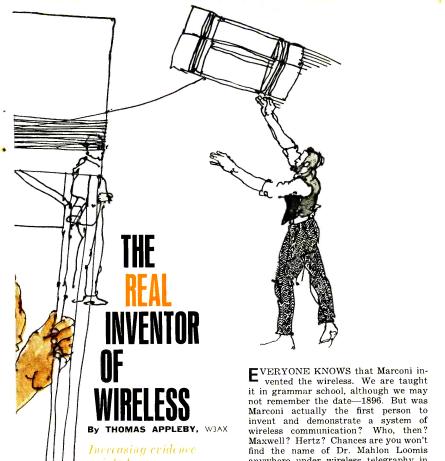It’s generally accepted in the history of science and technology that radio couldn’t have been invented until James Clerk Maxwell came up with Maxwell’s Equations in 1865. That theoretically underpinning of radio were verified experimentally by Heinrich Hertz in 1887. (Hertz, it turned out, was using electromagnetic waves of about two meters in wavelength, it turns, meaning that the first intentionally generated radio waves were probably in or near the two meter amateur band.)
The prevailing wisdom, which is more or less true, is that someone like Guglielmo Marconi in the 1890’s couldn’t have come along and turned radio into a practical device without the prior work of Maxwell and Hertz.
While that statement is generally true, it ignores Dr. Mahlon Loomis, a dentist and inventor who was born in 1826 and died in 1886, the year before Hertz’s experiments. And it appears that in 1866, he successfully communicated wirelessly between two mountains fourteen miles apart. Unfortunately, he produced no independent witnesses to verify the claim. And his understanding was that some layer of the sky was completing a direct-current circuit, using the atmosphere as a conductor to send the direct current.
Even though his explanation is impossible, it’s likely that he was sending and receiving radio signals. FIrst of all, his sending mechanism appears to have included a spark gap between the aerial and ground. And more critically, Loomis found that the system would work only if the two aerials were extended to the same length. He surmised that they were both coming into contact with the same level of the atmosphere, through which the DC current was conducted. But the more likely explanation is that the two antennas were both resonant to the same frequency of radio wave.
In 1872, he was issued U.S. Patent 129971 for his wireless telegraph. And in 1873, the U.S. Congress even chartered the Loomis Wireless Telegraph Company. Loomis was, however, never able to raise sufficient capital to make the venture a practical reality.
It’s probably true that radio pioneers such as Marconi couldn’t have succeeded without Maxwell and Hertz telling them that it was theoretically possible to send electromagnetic waves through space. But it’s not a foregone conclusion. Loomis shows that history could have played out the other way around: Someone could have accidentally discovered radio (as it appears that Loomis did), and only then the physicists could be called upon to explain how it works.
Fifty years ago this month, there was an interesting article about Loomis in Popular Electronics, October 1965, written by Thomas Appleby, W3AX. The illustration above is taken from that article. Appleby was also the author of Mahlon Loomis, Inventor of Radio, published in 1967.
lick Here For Today’s Ripley’s Believe It Or Not Cartoon
![]()

